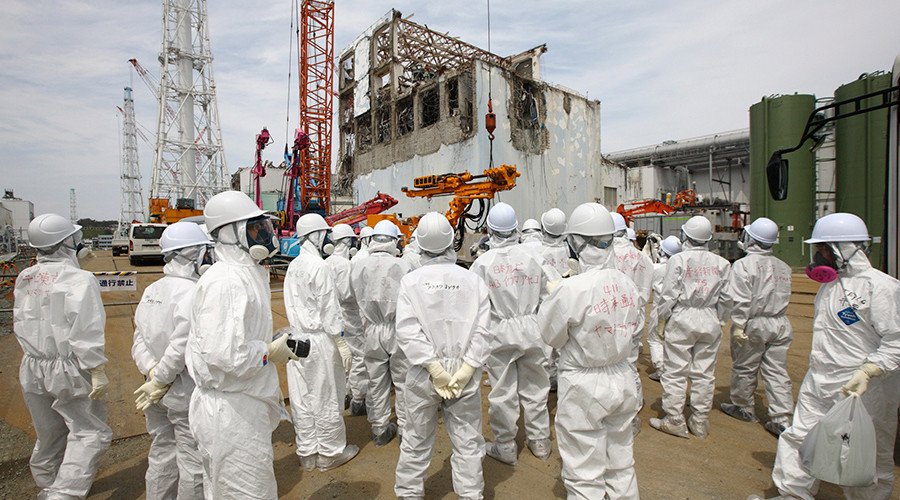Fukushima 5yrs on: Botched response, radiation danger, murky prospects
March 11 marks the fifth anniversary of the tsunami that led to the Fukushima disaster – the worst nuclear accident since Chernobyl. Five years on, the radiation is still not contained, and neither Japan’s energy industry, nor the country has recovered.
Official data says that no one was directly killed by the three meltdowns that followed the flooding of the Fukushima Daichii nuclear plant, compared to the 18,500 tragically killed by the tsunami. However, while Japanese towns along the coastline have long been rebuilt, the 40-year-old plant persists as a festering sore.
Some 70,000 people have yet to come back to the area, and may never do so, while the clean-up efforts have already cost Japan in excess of $21 billion, with the final bill predicted to top $105 billion.

It is not known how many people have succumbed to or suffer from radiation-caused cancer diseases directly linked to the crippled plant, but individual and collective lawsuits brought against Fukushima’s operator, Tokyo Electric Power Company (TEPCO), keep appearing in the news. This includes a 2014 class action filed by dozens of US Navy members from the USS Ronald Reagan, who took part in a cleanup effort near Fukushima in the aftermath of the tsunami, but were never warned of the radiation levels there. Several hundred sailors have since had fallen ill with various forms of cancer, including leukemia, thyroid cancer, and testicular cancer, while some had to have their organs removed or bore babies with unexplained birth defects.
Three executives who led Fukushima’s operator TEPCO in 2011 have just been charged with negligence, though they will plead innocent, saying that the rare combination of a massive earthquake and tsunami was impossible to predict. Nevertheless, TEPCO itself – which has had to be bailed out by the government, and is still struggling with overwhelming financial obligations – has recently admitted that it avoided using the word “meltdown” for two months after the first one occurred, and that it failed to follow its own safety procedures.

In the aftermath of the disaster and what has been widely considered an ineffective response, a Japanese ministry that was authorized as both a nuclear watchdog and promoter nuclear power has been replaced by an independent body – the Nuclear Regulation Authority.
About 150 tons of contaminated groundwater per day continues to leak out of the plant despite the installation of gargantuan water containers and some of the world’s most sophisticated purification systems. Those operating the plant say contaminants will continue to stream out until at least 2020.
A wall to be built around the reactor buildings from frozen soil, which has been touted as a solution for the past three years, has been repeatedly delayed due to safety concerns.

No schedule has been set for the removal of the molten nuclear fuel inside the reactors, as the technology to do so safely has not yet been approved. The operation is too dangerous for humans, while robots are proving to be clumsy and expensive.
More than 25,000 workers have been bussed in from all over the country to remove topsoil, fix damage, and create new infrastructure for the region. The media has alternately painted them as desperate misfits that terrify the locals, and exploited heroes who have often been scammed out of their danger payments by unscrupulous contractors.
Natives from this part of Japan’s east coast face stigma, poor economic prospects, and fear of radiation-borne illnesses, despite constant reassurance from the government that the area now has less radiation that many other parts of the country.

Crucially for the energy sector, the disaster brought about the closure of all of the country’s 44 working reactors, which were responsible for producing nearly a third of Japan’s energy output, ushering in an era of reliance on expensive and polluting fossil fuels.
Right-wing Prime Minister Shinzo Abe has fought an uphill battle to restore the country’s nuclear industry, despite opposition from over two-thirds of the Japanese population.
“Our resource-poor country cannot do without nuclear power to secure the stability of energy supply while considering what makes economic sense and the issue of climate change,” Abe said on the eve of the disaster’s anniversary.
He was dealt a blow this week, however, when courts ordered the shutdown of two of the four reactors that have re-opened in the past year, claiming they had not made sufficient progress in carrying out security upgrades that were stipulated in 2011. Twenty-five more reactors have pending applications to start up again, but most are unlikely to receive permits in the coming months, if not years.

In total, it is expected that the clean-up, compensation, and the creation of a new energy grid will now take Japan until 2061 – 50 years from the date of the disaster.
The idea of allowing people to move back to their homes near the Fukushima plant also seems to be “very premature and not a very good idea,” Nancy Foust of the Fukushima Project, which is investigating the disaster’s aftermath, told RT.
“Many of these areas are not truly safe. They have not been properly cleaned up, infrastructure has not been put back in place. There’s also the problem of proximity to the actual disaster site. They have a lot of complicated very risky work that they need to do over the next couple of decades to remove the melted fuel,” Foust explained.













